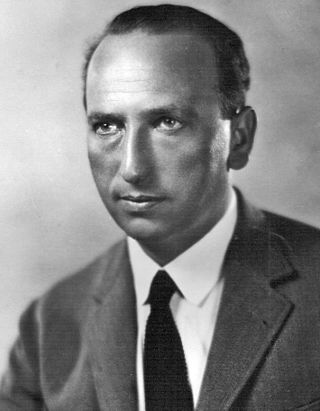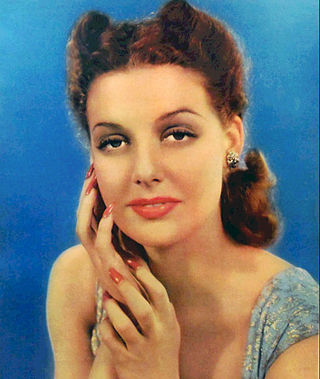
Humphrey DeForest Bogart, nicknamed Bogie, was an American actor. His performances in classic Hollywood cinema made him an American cultural icon. In 1999, the American Film Institute selected Bogart as the greatest male star of classic American cinema.

Casablanca is a 1942 American romantic drama film directed by Michael Curtiz and starring Humphrey Bogart, Ingrid Bergman, and Paul Henreid. Filmed and set during World War II, it focuses on an American expatriate (Bogart) who must choose between his love for a woman (Bergman) and helping her husband (Henreid), a Czechoslovak resistance leader, escape from the Vichy-controlled city of Casablanca to continue his fight against the Germans. The screenplay is based on Everybody Comes to Rick's, an unproduced stage play by Murray Burnett and Joan Alison. The supporting cast features Claude Rains, Conrad Veidt, Sydney Greenstreet, Peter Lorre, and Dooley Wilson.

Peter Lorre was a Hungarian and American actor, active first in Europe and later in the United States. He began his stage career in Vienna, in the Austro-Hungarian Empire, before moving to Germany, where he worked first on the stage, then in film, in Berlin during the late 1920s and early 1930s. Lorre caused an international sensation in the Weimar Republic–era film M (1931). Directed by Fritz Lang, Lorre portrayed a serial killer who preys on little girls.

Michael Curtiz was a Hungarian-American film director, recognized as one of the most prolific directors in history. He directed classic films from the silent era and numerous others during Hollywood's Golden Age, when the studio system was prevalent.

Sydney Hughes Greenstreet was a British and American actor. While he did not begin his career in films until the age of 61, he had a run of significant motion pictures in a Hollywood career lasting through the 1940s. He is best remembered for the three Warner Bros. films - The Maltese Falcon (1941), Casablanca (1942), and Passage to Marseille (1944) - with both Humphrey Bogart and Peter Lorre. He portrayed Nero Wolfe on radio during 1950 and 1951. He became an American citizen in 1925.

Clara Lou "Ann" Sheridan was an American actress and singer. She is best known for her roles in the films San Quentin (1937) with Humphrey Bogart, Angels with Dirty Faces (1938) with James Cagney and Bogart, They Drive by Night (1940) with George Raft and Bogart, City for Conquest (1940) with Cagney and Elia Kazan, The Man Who Came to Dinner (1942) with Bette Davis, Kings Row (1942) with Ronald Reagan, Nora Prentiss (1947), and I Was a Male War Bride (1949) with Cary Grant.

Kay Francis was an American stage and film actress. After a brief period on Broadway in the late 1920s, she moved to film and achieved her greatest success between 1930 and 1936, when she was the number one female star and highest-paid actress at Warner Bros. studio. She adopted her mother's maiden name (Francis) as her professional surname.

George Raft was an American film actor and dancer identified with portrayals of gangsters in crime melodramas of the 1930s and 1940s. A stylish leading man in dozens of movies, Raft is remembered for his gangster roles in Quick Millions (1931) with Spencer Tracy, Scarface (1932) with Paul Muni, Each Dawn I Die (1939) with James Cagney, Invisible Stripes (1939) with Humphrey Bogart, and Billy Wilder's comedy Some Like It Hot (1959) with Marilyn Monroe and Jack Lemmon; and as a dancer in Bolero (1934) with Carole Lombard and a truck driver in They Drive by Night (1940) with Ann Sheridan, Ida Lupino and Bogart.

Glenda Farrell was an American actress. Farrell personified the smart and sassy, wisecracking blonde of the Classic Hollywood films. Her career spanned more than 50 years, and she appeared in numerous Broadway plays, films and television series. She won an Emmy Award in 1963 for Outstanding Supporting Actress for her performance as Martha Morrison in the medical drama television series Ben Casey.

Dolores Costello was an American film actress who achieved her greatest success during the era of silent movies. She was nicknamed "The Goddess of the Silent Screen" by her first husband, the actor John Barrymore. She was the mother of John Drew Barrymore and grandmother of actress and talk show host Drew Barrymore.

The Big Sleep is a 1946 American film noir directed by Howard Hawks. William Faulkner, Leigh Brackett and Jules Furthman co-wrote the screenplay, which adapts Raymond Chandler's 1939 novel. The film stars Humphrey Bogart as private detective Philip Marlowe and Lauren Bacall as Vivian Rutledge in a story that begins with blackmail and leads to multiple murders.
To Have and Have Not is a 1944 American romantic war adventure film directed by Howard Hawks, loosely based on Ernest Hemingway's 1937 novel of the same name. It stars Humphrey Bogart, Walter Brennan and Lauren Bacall; it also features Dolores Moran, Hoagy Carmichael, Sheldon Leonard, Dan Seymour, and Marcel Dalio. The plot, centered on the romance between a freelancing fisherman in Martinique and a beautiful American drifter, is complicated by the growing French resistance in Vichy France.

Helmut Dantine was an Austrian-American actor who often played Nazis in thriller films of the 1940s. His best-known performances are perhaps the German pilot in Mrs. Miniver and the desperate Bulgarian refugee in Casablanca, who tries gambling to obtain travel visa money for himself and his wife. As his acting career waned, he turned to producing.

Conflict is a 1945 American black-and-white suspense film noir made by Warner Brothers. It was directed by Curtis Bernhardt, produced by William Jacobs from a screenplay by Arthur T. Horman and Dwight Taylor, based on the story The Pentacle by Alfred Neumann and Robert Siodmak. It starred Humphrey Bogart, Alexis Smith, and Sydney Greenstreet. The film is the only pairing of Bogart and Greenstreet of the five in which they acted together where Bogart rather than Greenstreet is the villain or corrupt character. There is also a cameo appearance of the Maltese Falcon statue.

The Maltese Falcon is a 1941 American film noir written and directed by John Huston in his directorial debut. Based on the 1930 novel The Maltese Falcon by Dashiell Hammett, this remakes the 1931 film of the same name.

Marie Madeleine Berthe Lebeau was a French film actress who also appeared in American films, most notably Casablanca.

Warner Bros. Presents is the umbrella title for three series that were telecast as part of the 1955–56 season on ABC: Cheyenne, a new Western series that originated on Presents, and two based on classic Warner Bros motion picture properties, becoming Casablanca and Kings Row. The series ran from September 13, 1955, until September 4, 1956, or September 11, 1956.

Jane Bryan was an American actress groomed by Warner Bros. to become one of its leading ladies but she chose to retire from acting in 1940 at age 22, after which she became a philanthropist and arts patron.
William T. Orr was an American actor and television producer associated with various Western and detective programs of the 1950s-1970s. In most of his Warner Bros. series, he was billed as "Wm. T. Orr." Orr began his career as an actor; his film credits included The Mortal Storm, The Gay Sisters, and The Big Street.
Casablanca is an hour-long American television series, in the genre of spying and intrigue during the Cold War, which was broadcast on ABC between September 27, 1955 and April 24, 1956 as part of the wheel series Warner Bros. Presents. The third of 20 filmed shows produced for ABC, between 1955 and 1963, by Warner Bros. Television, under the supervision of executive producer William T. Orr, Casablanca is also the only one among those shows to be structured in the form of a non-U.S.-based Cold-War-intrigue storyline, while 14 of the 20 productions were western and detective/adventure series.

















